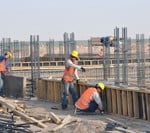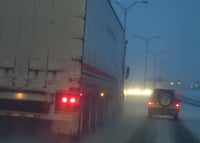 If your workers need to reach, lift and carry, twist their bodies, or perform other activities that place them under strain, their shoulders might be at risk.
If your workers need to reach, lift and carry, twist their bodies, or perform other activities that place them under strain, their shoulders might be at risk.
As the most mobile and one of the most versatile joints in the body, the shoulder is highly vulnerable to musculo-skeletal disorders (MSDs). Recovering from these injuries takes an average of 21 days – one of the longest recovery periods for on-the-job accidents.
To help keep your workers’ shoulders healthy, and your Workers Comp premiums under control, we’d recommend these guidelines.
- Minimize lifting. Provide mechanical assists (carts, slings, dollies, jacks, etc.) to raise and hold objects. Put materials as close as practical to where they will be used
- Lighten the load. When lifting can’t be eliminated, or when objects (such as tools) must be held at arm’s length, make sure these items are as light as possible, In construction, for example, use lighter-weight building materials. Have a team lift all heavy objects.
- Control motion. One of the most dangerous situations is a “save” – when a load shifts or slips and a worker attempts to prevent a fall. To reduce this danger, hold work pieces in place using a jack or brace.
- Improve the grip. Lifting requires more force, and is more difficult (and more likely to cause injury) when there’s no easy way to grasp the object – for example, drywall panels. One solution: apply removable suction handles and temporary handles to flat surfaces.
- Encourage rest and stretching. Workers can minimize damage from jobs that put stress on their shoulder joints by taking frequent short breaks (15-20 seconds) and stretching gently to relieve tension in over-worked muscles and ligaments.
For more information, please get in touch with our workplace safety experts.
Read more
 No matter how much care you take to keep job sites safe and finish projects according to specifications, accidents happen. Consider these scenarios:
No matter how much care you take to keep job sites safe and finish projects according to specifications, accidents happen. Consider these scenarios:
- an improperly installed kitchen cabinet shelf in a home you built collapses, injuring the owner
- one of your employees posts a blog accusing a competitor of shoddy workmanship
- a visitor to your worksite trips over an air hose, falls, and fractures her leg
To protect your business against the financial threat of costly litigation from such all-too-common mishaps, you need construction liability insurance.
This coverage will pay costs and legal expenses, up to the amount of the policy, for something your business did, or failed to do, that damages a third party, related to 1) your products or services (products and completes operations); 2) allegations of slander (personal and advertising injury); or 2) injury on your premises or job site (medical expenses).
As a common business practice, both residential and commercial clients will require you,and your subcontractors, to show evidence of construction liability insurance before starting a job.
In general, residential contractors should buy coverage two to three times the amount of the construction budget. Commercial contractors usually carry policies in the multi-million dollar range. Firms that face higher risk of damages, for example, roofing contractors or those in specialized trades, tend to have more coverage. Some contractors prefer to pay their premiums up front, while others make a down payment and finance the premium over the policy period (six months to a year).
No matter how large or small your business, having comprehensive construction liability insurance is always the best policy.
We’d be happy to review your situation and recommend the coverage that’s best suited for you.
Read more
 Eggnog, latkes, old friends, parties – and a lot of beveraging! HR That Works wishes you a safe and happy holiday season! As the host of your company party, you have a legal obligation to make sure that attendees get home safe. Here’s our list of tips to help you meet this responsibility:
Eggnog, latkes, old friends, parties – and a lot of beveraging! HR That Works wishes you a safe and happy holiday season! As the host of your company party, you have a legal obligation to make sure that attendees get home safe. Here’s our list of tips to help you meet this responsibility:
- Make party attendance voluntary.
- Hire bartenders trained to spot and handle intoxicated revelers.
- Provide non-alcoholic beverages.
- Give each guest a limited number of drink tickets, instead of an open bar.
- Serve filling food – not just chips and pretzels – whenever alcohol is available.
- Cut off alcohol service at least an hour before the party ends.
- Stop serving intoxicated guests immediately; don’t wait until they’re ready to leave.
- Never ask an apparently impaired guest if they’re able to drive home – they aren’t.
- Provide a taxi service for guests who require or request it.
- Have a friend or family member pick up intoxicated guests.
- Arrange for discounted rooms at the event location or a nearby hotel.
Finally, have a fun party. Think like good ‘ol Mr. Fezziwig!
Accommodating Religious Needs
The holiday season is an ideal time to focus on religious accommodation in in the workplace. Title 7 of the Civil Rights Act of 1964 prohibits discrimination based on religion. We’ve seen more of these claims in recent years, with thousands of claims filed in 2012. Unsurprising, many of these cases include allegations of discrimination based national origin (i.e. someone claims discrimination because they’re of Arab origin, as well as Muslim).
The EEOC offers this definition of “religion:”
“In most cases, whether or not a practice or a belief is religious is not an issue. However, the EEOC defines religious practices to include moral or ethical beliefs as to what’s right and wrong, which are sincerely held with the strength of traditional, religious views. The fact that no religious group espouses such beliefs, or that the religious group to which the individual professes to belong might not accept such belief, will not determine whether the belief is a religious belief of the employee or prospective employee. The phrase ‘religious practices’ includes both religious observances and practices.” Also, bear in mind that:
- It’s unlawful for an employer to fail to accommodate reasonably the religious practices of an employee or prospective employee, unless the employer demonstrates that accommodation will mean undue hardship in conducting its business.
- An employer may not ask about an employee’s religious background unless justified by business necessity.”
For more information on religious expression in the workplace, check out: 1) EEOC guidelines and FAQS on religious discrimination: 2) an EEOC memo on accommodating religious expression; and 3) religious accommodation practices at the University of Missouri ( a great education, period).
Read more
 As kids, we learn that there are two ways to get in trouble: doing stuff we shouldn’t (giving the dog a haircut) or not doing things we should (letting Fido go hungry).
As kids, we learn that there are two ways to get in trouble: doing stuff we shouldn’t (giving the dog a haircut) or not doing things we should (letting Fido go hungry).
As a contractor, you can get into serious trouble for not doing something,– under a legal doctrine called “negligent supervision.” For example, if one of your employees injures another person by driving a car recklessly while on company business, you might face a negligent supervision lawsuit alleging that you failed to uncover or ignored the driver’s bad record behind the wheel.
To minimize this risk, experts recommend that you:
Understand your exposure to potential negligence. Although it’s an exaggeration to say that anything you do (or don’t do) might be seen as negligent, certain situations demand particular care Promoting or certifying unqualified employees, failing to fire or discipline them for potentially dangerous behavior, or terminating them without an effective investigation.
Never make assumptions about employees. Just because workers volunteer for additional responsibilities for which they might be unqualified (out of boredom, a wish to please, or to earn a higher wage) doesn’t mean they can actually do the work. Check the employees petitions before assigning the work.
Don’t ignore or minimize signs that employees pose a potential danger to themselves or others. After the tragic shootings at the Washington Navy Yard, the media was filled with evidence of the shooter’s troubling behavior that the authorities evidently ignored. If you’re concerned about an employee’s actions, investigate, inquire, and consult with experts, including the police. It’s better to be safe than sorry!
We’d be happy to review your exposure to negligent supervision claims and how liability insurance can protect you against these allegations.
Read more
 You’re traveling at 70 miles per hour on a busy highway when you blow a tire. Your car hits an unexpected slick spot and starts to fishtail. Your brakes or steering suddenly lock up.
You’re traveling at 70 miles per hour on a busy highway when you blow a tire. Your car hits an unexpected slick spot and starts to fishtail. Your brakes or steering suddenly lock up.
In these situations, preparedness can literally make the difference between life and death. That means making sure your employees are trained to deal with common driving emergencies by following these guidelines:
A blown tire:
- Hang on to the steering wheel.
- Don’t brake suddenly.
- Ease off the gas and coast until you have control of the car.
- Turn on your hazard lights to warn the drivers around you.
- Steer smoothly.
Skidding or hydroplaning:
- Don’t make any sudden moves, such as braking hard or jerking the wheel.
- Ease off the gas.
- Steer the car’s nose gently in the direction you’d like to go. Make adjustments gradually, as needed, until the vehicle is moving in a straight line.
Failed steering:
- Don’t brake – a sudden change in speed could send the car spinning.
- Ease off the gas.
- Turn on your hazard lights.
- Coast to a stop, using your brakes gently once the car slows on its own.
Your brakes fail:
- Downshift.
- Move to the right, remembering to signal as needed.
- Because the failure might be temporary, keep your foot on the brakes. If you have ABS, apply steady pressure; If you don’t have ABS, pump the brakes.
- Shift into neutral and apply your emergency brake.
- If possible, use friction to slow or stop the vehicle by running it along a curb or something alongside the road.
For more information, feel free to get in touch with us.
Read more

“Once you start practicing being grateful and thankful for things, people, and events, you may notice that you start to attract more positive things, people, and events in your life.”
Stephanie Conkle
Read more
 If your workers need to reach, lift and carry, twist their bodies, or perform other activities that place them under strain, their shoulders might be at risk.
If your workers need to reach, lift and carry, twist their bodies, or perform other activities that place them under strain, their shoulders might be at risk.
 No matter how much care you take to keep job sites safe and finish projects according to specifications, accidents happen. Consider these scenarios:
No matter how much care you take to keep job sites safe and finish projects according to specifications, accidents happen. Consider these scenarios:


